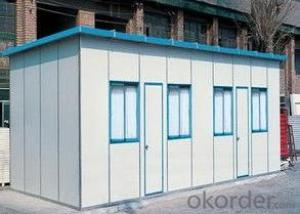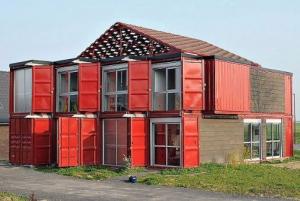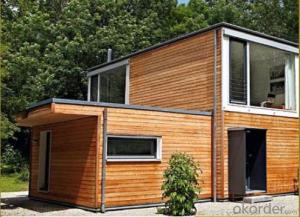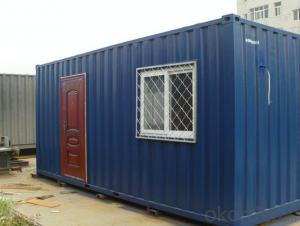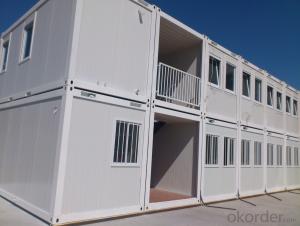Economic Modular Container Homes
- Loading Port:
- China Main Port
- Payment Terms:
- TT OR LC
- Min Order Qty:
- -
- Supply Capability:
- -
OKorder Service Pledge
OKorder Financial Service
You Might Also Like
Container House & HOME
Economic Modular Container Homes
Lifetime | 20-25 years |
Steel Frame | 4mm thickness steel pillar (baking finish)+3mm steel beam (Hot-galvanized) |
Wall Panel | 60mm EPS/Rockwool/PU sandwich panel |
Roof | (1)First layer: 0.5mm Hot-galvanized steel sheet (2)Second layer: 100mm glass wool insulation (3)Third layer: 50mm EPS/PU/Rockwool Sandwich Panel |
Bottom | (1)First layer:1.8 mm PVC floor (2)Second layer:18mm plywood for office,living etc. Cement fiberboard for bathroom with good water-proof (3)Third layer:100mm Insulation (4)Forth layer:0.5mm Hot-galvanized steel sheet |
Door/windows | one steel door and two PVC sliding windows |
Electricity | (1)1 distribution box;1 circuit breaker; (2)2 Ceiling lights ; 3 sockets(1 is A/C socket); (3)1 switch; |
Usage | Accommodation,office,living room,hotel,meeting room, dormitory, shop, booth, toilet, storage, kitchen, shower room and so on. |
Package | (1) 4 sets Flat-packing without shipping container (2) 6 sets loading in 40'High shipping Container; (3)The inner shower room and other furniture will be packed separately in shipping container.
|
- Q:Can container houses be designed with rooftop gardens?
- Yes, container houses can be designed with rooftop gardens. The modular and versatile nature of container houses allows for the installation of rooftop gardens, providing an eco-friendly and sustainable option for growing plants and vegetables. Additionally, rooftop gardens can enhance the aesthetics of container houses while providing numerous environmental benefits such as insulation, rainwater harvesting, and improved air quality.
- Q:What type of foundation is needed for a container house?
- Various factors, such as soil conditions, climate, local building codes, and the intended use of the structure, influence the type of foundation necessary for a container house. Container houses can be supported by several common types of foundations. One possibility is a concrete slab foundation, where a solid concrete pad is poured directly for the containers to rest upon. This foundation is cost-effective and provides stability, although it may require excavation and site preparation. Another option is a pier foundation, which entails placing concrete piers or footings under the corners of each container, and occasionally along the walls for added support. This type of foundation is suitable for uneven terrains or areas with poor soil conditions. It promotes better airflow beneath the containers and can be more cost-effective in certain cases. In regions with high water tables or prone to flooding, a raised foundation or stilts might be necessary. This involves elevating the containers on piers, columns, or stilts to keep them above flood levels. This foundation protects against potential water damage and improves ventilation and airflow. To determine the most suitable foundation for your specific container house project, it is crucial to consult a structural engineer or an experienced professional in container house construction. They will consider factors like soil testing, local regulations, and desired load-bearing capacity to ensure a safe and structurally sound foundation for the container house.
- Q:Are container houses suitable for senior living communities?
- Indeed, container houses can be a viable option for senior living communities due to various factors. Firstly, the adaptability of container houses allows for customization to cater to the specific needs of senior citizens. Modifications, such as wider doorways, ramps, and grab bars, can be easily incorporated to enhance accessibility for seniors with mobility impairments. Moreover, the layout of container houses can be adjusted to accommodate medical equipment like wheelchairs and walkers. Secondly, container houses present a cost-effective solution for senior living communities. Compared to traditional housing options, they often offer more affordability, making them appealing for seniors with limited financial resources. The construction and maintenance expenses associated with container houses tend to be lower than those of conventional homes, resulting in a more financially sustainable choice for senior living communities. Furthermore, container houses contribute to environmental friendliness. By utilizing repurposed shipping containers, they contribute to waste reduction and have a smaller carbon footprint compared to conventional housing. This aligns with the increasing popularity of sustainable living, which is gaining traction among seniors as well. Additionally, container houses can foster a sense of community among seniors. The compact nature of these houses promotes closer proximity between neighbors, facilitating social interactions and a stronger support network. This aspect is particularly significant for seniors who may face the risk of isolation or loneliness. However, it is crucial to acknowledge that the suitability of container houses for senior living communities may also rely on the specific needs and preferences of the seniors involved. Some seniors may prefer the familiarity and aesthetics of traditional housing, while others may have particular health or care requirements that container houses may not adequately address. Therefore, it is essential to carefully consider the individual needs and preferences of seniors before determining whether container houses are suitable for a particular senior living community.
- Q:Can container houses be designed to have a walk-in closet?
- Yes, container houses can definitely be designed to have a walk-in closet. While the size of a walk-in closet may vary depending on the dimensions of the container, it is indeed possible to incorporate this feature into the design. With the right planning and utilization of available space, a container house can offer a functional and aesthetically pleasing walk-in closet. Customization options such as installing shelves, hanging rods, shoe racks, drawers, and mirrors can further enhance the functionality and storage capacity of the closet. Ultimately, the design and layout of a container house can be tailored to meet individual preferences and needs, including the inclusion of a walk-in closet.
- Q:Are container houses suitable for areas with limited access to construction materials?
- Yes, container houses are suitable for areas with limited access to construction materials. Container houses are constructed using shipping containers, which are readily available and can be transported even to remote areas. These containers provide a strong and sturdy base for building a house, making them suitable for areas with limited access to traditional construction materials. Additionally, container houses can be easily customized and modified to fit the specific needs and climate conditions of the area. They can also be designed to be self-sufficient, incorporating renewable energy sources and water collection systems, further reducing the reliance on external construction materials and resources. Overall, container houses offer a viable solution for areas with limited access to construction materials, providing a quick, cost-effective, and sustainable housing option.
- Q:Can container houses be designed with a built-in laundry room?
- Yes, container houses can definitely be designed with a built-in laundry room. The versatility and customizability of container homes allow for various design options, including the inclusion of a laundry room. By cleverly utilizing the available space within the container, architects and designers can create functional and efficient laundry rooms that fit seamlessly into the overall layout of the house. This can be achieved by incorporating space-saving features such as stackable or compact laundry appliances, innovative storage solutions, and smart design elements. Additionally, with proper planning and utilization of plumbing and electrical systems, container houses can easily accommodate the necessary connections and installations for a fully functional laundry room.
- Q:Are container houses suitable for individuals who prefer a minimalist lifestyle?
- Yes, container houses are definitely suitable for individuals who prefer a minimalist lifestyle. Container houses are known for their simplicity and efficiency, making them a perfect choice for minimalists. These houses are built using recycled shipping containers, which means they have a limited amount of space. This limitation forces individuals to downsize and prioritize their belongings, making it easier to adopt a minimalist mindset. Container houses are designed to maximize space utilization and minimize waste. They often feature open floor plans and clever storage solutions, allowing minimalists to have a clutter-free living environment. The small size of container houses also encourages individuals to focus on essential items and avoid unnecessary possessions. Furthermore, container houses can be customized to suit minimalist preferences. The interior design can be kept clean and minimal, with simple and functional furniture, neutral color schemes, and plenty of natural light. By keeping the design minimal and uncluttered, individuals can create a peaceful and calming living space that aligns with their minimalist lifestyle. In addition to their minimalist appeal, container houses also offer sustainability benefits. By repurposing shipping containers, these houses contribute to reducing waste and promoting eco-friendly living. Minimalists often value sustainability and ethical choices, making container houses an excellent option for those seeking a minimalist lifestyle without compromising their environmental values. Overall, container houses provide a practical and aesthetic solution for individuals who prefer a minimalist lifestyle. These houses offer simplicity, efficiency, sustainability, and creative design possibilities, making them an ideal choice for minimalists seeking a balanced and intentional way of living.
- Q:Are container houses resistant to high temperatures or heatwaves?
- Container houses can be resistant to high temperatures or heatwaves, but it depends on how they are designed and insulated. These houses are typically made from steel, which has a high thermal conductivity. This means that without proper insulation, container houses can quickly heat up in high temperatures. However, many container houses are built with insulation materials such as foam or spray foam insulation, which helps to regulate the interior temperature and prevent heat transfer. Additionally, other measures like reflective roof coatings or shade structures can be added to further reduce heat absorption and keep the interior cool. It is important to note that container houses, like any other type of housing, require proper ventilation and air conditioning systems to effectively combat high temperatures or heatwaves. Without these systems, even with insulation, container houses may not be able to withstand extreme heat. Overall, container houses can be resistant to high temperatures or heatwaves if they are properly designed, insulated, and equipped with the necessary ventilation and cooling systems.
- Q:Can container houses be built in urban areas?
- Container houses are indeed able to be constructed in urban areas, and they are actually gaining popularity as a sustainable and cost-effective housing choice in densely populated cities. These houses are constructed using repurposed shipping containers, which can be easily stacked and arranged to form multi-story structures. They can be customized and designed to meet the specific needs and aesthetics of urban living. Moreover, container houses are frequently more affordable than traditional housing options, making them an appealing choice for individuals and families seeking to reside in urban areas. Additionally, container houses can be easily transported and assembled, allowing for flexibility and mobility, which is often desired in urban environments where land availability and zoning regulations may pose limitations. Overall, container houses present a viable and innovative solution for urban housing, addressing the increasing demand for affordable and sustainable living choices in cities.
- Q:Can container houses be designed with a rooftop deck or terrace?
- Yes, container houses can be designed with a rooftop deck or terrace. The modular nature of container homes allows for various design possibilities, including the addition of a rooftop deck or terrace. This feature not only maximizes outdoor living space but also enhances the overall aesthetic appeal and functionality of the container house.
1. Manufacturer Overview |
|
|---|---|
| Location | |
| Year Established | |
| Annual Output Value | |
| Main Markets | |
| Company Certifications | |
2. Manufacturer Certificates |
|
|---|---|
| a) Certification Name | |
| Range | |
| Reference | |
| Validity Period | |
3. Manufacturer Capability |
|
|---|---|
| a)Trade Capacity | |
| Nearest Port | |
| Export Percentage | |
| No.of Employees in Trade Department | |
| Language Spoken: | |
| b)Factory Information | |
| Factory Size: | |
| No. of Production Lines | |
| Contract Manufacturing | |
| Product Price Range | |
Send your message to us
Economic Modular Container Homes
- Loading Port:
- China Main Port
- Payment Terms:
- TT OR LC
- Min Order Qty:
- -
- Supply Capability:
- -
OKorder Service Pledge
OKorder Financial Service
Similar products
New products
Hot products
Hot Searches
Related keywords

